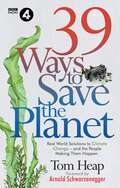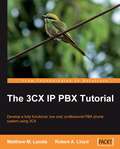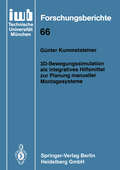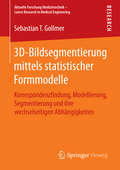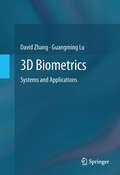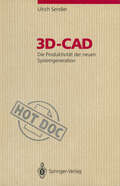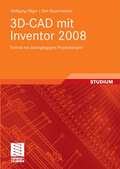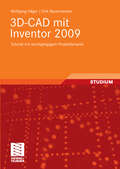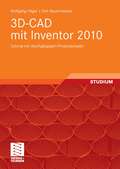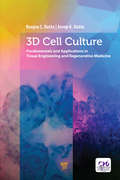- Table View
- List View
The 37th Annual Conference on Power System and Automation in Chinese Universities (Lecture Notes in Electrical Engineering #1030)
by Xiao-Ping Zhang Yi Ding Pingliang Zeng Vladimir Terzija Yunxia LuoThis book includes original, peer-reviewed research papers from the 37th Annual Conference of Power System and Automation in Chinese Universities (CUS-EPSA), held in Hangzhou, China on October 23-25, 2022. These papers cover topics as Evolution and development path of the power system, Resilience assessment, analysis and planning of power system, Power system planning and reliability, Modelling and simulation of novel power system, Power electronic for power system stability analysis, Power system relay protection and automation and so on. The papers included in this proceedings share the latest research results and practical application examples on the methodologies and algorithms in these areas, which makes the book a valuable reference for researchers, engineers, and university students.
39 Ways to Save the Planet
by Tom HeapWe got ourselves into this. Here's how we can get ourselves out.We know the problem: the amount of biodiversity loss, the scale of waste and pollution, the amount of greenhouse gas we pump into the air... it's unsustainable. We have to do something. And we are resourceful, adaptable and smart. We have already devised many ways to reduce climate change - some now proven, others encouraging and craving uptake. Each one is a solution to get behind.In 39 Ways to Save the Planet, Tom Heap reveals some of the real-world solutions to climate change that are happening around the world, right now. From tiny rice seeds and fossil fuel free steel to grazing elk and carbon-capturing seagrass meadows, each chapter reveals the energy and optimism in those tackling the fundamental problem of our age. Accompanying a major BBC Radio 4 series in collaboration with the Royal Geographical Society, 39 Ways to Save the Planet is a fascinating exploration of our attempt to build a better future, one solution at a time. A roadmap to global action on climate change, it will encourage you to add your own solutions to the list.
3c: A Proven Alternative to MRPII for Optimizing Supply Chain Performance
by F Xavier Gurrola-Gal Miguel Fernandez-Ranada Enrique Lopez-TelloLack of materials or goods to satisfy customer orders under current market conditions represents an extremely costly and important problem facing businesses today. This is a problem that companies have spent hundreds of millions of dollars trying to solve. This book introduces a new theory, 3C, which will solve these problems. The authors, experts from Lucent Technologies, discuss in detail the relationship between the 3Cs - capacity, commonality, and consumption - and how this relationship can revolutionize your business. You will learn how to: reduce overhead expense and improve shipping performance by using the business capacity as the basis for materials planning; reduce investments in inventory by using the commonality of components; obtain dramatic improvements in the lead time of customer orders by using the actual consumption of materials instead of inaccurate sales forecasts as the basis for purchasing. The new and exciting techniques based on 3C generate immediate business benefits, for example: executing the purchasing function with a new criteria and formulae that can eliminate material shortages and significantly improve shipping performance, sales volumes, operating expense and company image.3C-A Proven Alternative to MRPII for Optimizing Supply Chain Performance gives you the knowledge and practical guidelines to better manage end-to-end Supply Chains and eliminate the expensive and annoying problem of material shortages that most businesses suffer.Features
3c: A Proven Alternative to MRPII for Optimizing Supply Chain Performance
by F Xavier Gurrola-Gal Miguel Fernandez-Ranada Enrique Lopez-TelloLack of materials or goods to satisfy customer orders under current market conditions represents an extremely costly and important problem facing businesses today. This is a problem that companies have spent hundreds of millions of dollars trying to solve. This book introduces a new theory, 3C, which will solve these problems. The authors, experts from Lucent Technologies, discuss in detail the relationship between the 3Cs - capacity, commonality, and consumption - and how this relationship can revolutionize your business. You will learn how to: reduce overhead expense and improve shipping performance by using the business capacity as the basis for materials planning; reduce investments in inventory by using the commonality of components; obtain dramatic improvements in the lead time of customer orders by using the actual consumption of materials instead of inaccurate sales forecasts as the basis for purchasing. The new and exciting techniques based on 3C generate immediate business benefits, for example: executing the purchasing function with a new criteria and formulae that can eliminate material shortages and significantly improve shipping performance, sales volumes, operating expense and company image.3C-A Proven Alternative to MRPII for Optimizing Supply Chain Performance gives you the knowledge and practical guidelines to better manage end-to-end Supply Chains and eliminate the expensive and annoying problem of material shortages that most businesses suffer.Features
The 3CX IP PBX Tutorial: Develop A Fully Functional, Low Cost, Professional Pbx Phone System Using 3cx
by Matthew M. Landis Robert Lloyd3D and Circuit Integration of MEMS
by Masayoshi EsashiExplore heterogeneous circuit integration and the packaging needed for practical applications of microsystems MEMS and system integration are important building blocks for the “More-Than-Moore” paradigm described in the International Technology Roadmap for Semiconductors. And, in 3D and Circuit Integration of MEMS, distinguished editor Dr. Masayoshi Esashi delivers a comprehensive and systematic exploration of the technologies for microsystem packaging and heterogeneous integration. The book focuses on the silicon MEMS that have been used extensively and the technologies surrounding system integration. You’ll learn about topics as varied as bulk micromachining, surface micromachining, CMOS-MEMS, wafer interconnection, wafer bonding, and sealing. Highly relevant for researchers involved in microsystem technologies, the book is also ideal for anyone working in the microsystems industry. It demonstrates the key technologies that will assist researchers and professionals deal with current and future application bottlenecks. Readers will also benefit from the inclusion of: A thorough introduction to enhanced bulk micromachining on MIS process, including pressure sensor fabrication and the extension of MIS process for various advanced MEMS devices An exploration of epitaxial poly Si surface micromachining, including process condition of epi-poly Si, and MEMS devices using epi-poly Si Practical discussions of Poly SiGe surface micromachining, including SiGe deposition and LP CVD polycrystalline SiGe A concise treatment of heterogeneously integrated aluminum nitride MEMS resonators and filters Perfect for materials scientists, electronics engineers, and electrical and mechanical engineers, 3D and Circuit Integration of MEMS will also earn a place in the libraries of semiconductor physicists seeking a one-stop reference for circuit integration and the practical application of microsystems.
3D and Circuit Integration of MEMS
by Masayoshi EsashiExplore heterogeneous circuit integration and the packaging needed for practical applications of microsystems MEMS and system integration are important building blocks for the “More-Than-Moore” paradigm described in the International Technology Roadmap for Semiconductors. And, in 3D and Circuit Integration of MEMS, distinguished editor Dr. Masayoshi Esashi delivers a comprehensive and systematic exploration of the technologies for microsystem packaging and heterogeneous integration. The book focuses on the silicon MEMS that have been used extensively and the technologies surrounding system integration. You’ll learn about topics as varied as bulk micromachining, surface micromachining, CMOS-MEMS, wafer interconnection, wafer bonding, and sealing. Highly relevant for researchers involved in microsystem technologies, the book is also ideal for anyone working in the microsystems industry. It demonstrates the key technologies that will assist researchers and professionals deal with current and future application bottlenecks. Readers will also benefit from the inclusion of: A thorough introduction to enhanced bulk micromachining on MIS process, including pressure sensor fabrication and the extension of MIS process for various advanced MEMS devices An exploration of epitaxial poly Si surface micromachining, including process condition of epi-poly Si, and MEMS devices using epi-poly Si Practical discussions of Poly SiGe surface micromachining, including SiGe deposition and LP CVD polycrystalline SiGe A concise treatment of heterogeneously integrated aluminum nitride MEMS resonators and filters Perfect for materials scientists, electronics engineers, and electrical and mechanical engineers, 3D and Circuit Integration of MEMS will also earn a place in the libraries of semiconductor physicists seeking a one-stop reference for circuit integration and the practical application of microsystems.
3D Audio (Perspectives on Music Production)
by Justin Paterson Hyunkook Lee3D Audio offers a detailed perspective of this rapidly developing arena. Written by many of the world’s leading researchers and practitioners, it draws from science, technologies, and creative practice to provide insight into cutting-edge research in 3D audio. Through exploring the intersection of these fields, the reader will gain insight into a number of research areas and professional practice in 3D sonic space. As such, the book acts both as a primer that enables readers to gain an understanding of various aspects of 3D audio, and can inform students and audio enthusiasts, but its deep treatment of a diverse range of topics will also inform professional practitioners and academics beyond their core specialisms. The chapters cover areas such as an Ambisonics, binaural technologies and approaches, psychoacoustics, 3D audio recording, composition for 3D space, 3D audio in live sound, broadcast, and movies – and more. Overall, this book offers a definitive insight into an emerging sound world that increasingly becoming part of our everyday lives.
3D-Bewegungssimulation als integratives Hilfsmittel zur Planung manueller Montagesysteme (iwb Forschungsberichte #66)
by Günter Kummetsteiner3D-Bildsegmentierung mittels statistischer Formmodelle: Korrespondenzfindung, Modellierung, Segmentierung und ihre wechselseitigen Abhängigkeiten (Aktuelle Forschung Medizintechnik – Latest Research in Medical Engineering)
by Sebastian T. GollmerSebastian T. Gollmer entwickelt neue Methoden und Algorithmen für die Erstellung statistischer Formmodelle, die Formmodellierung und die formmodellbasierte Bildsegmentierung. Der Autor diskutiert ihre Vorteile gegenüber den jeweils etablierten Verfahren aus der Literatur und evaluiert den generellen Einfluss dieser drei Aspekte auf die erzielbare Segmentierungsgenauigkeit. Letzteres erfolgt sowohl unter Verwendung neu entwickelter und etablierter Evaluierungsverfahren als auch im Rahmen realer Anwendungen. Von besonderer praktischer Relevanz zeigen sich dabei die exzellenten, mit einem neuen vollautomatischen Algorithmus erzielten Ergebnisse für die Unterkiefersegmentierung.
3D Biometrics: Systems and Applications
by David Zhang Guangming LuAutomatic personal authentication using biometric information is becoming more essential in applications of public security, access control, forensics, banking, etc. Many kinds of biometric authentication techniques have been developed based on different biometric characteristics. However, most of the physical biometric recognition techniques are based on two dimensional (2D) images, despite the fact that human characteristics are three dimensional (3D) surfaces. Recently, 3D techniques have been applied to biometric applications such as 3D face, 3D palmprint, 3D fingerprint, and 3D ear recognition. This book introduces four typical 3D imaging methods, and presents some case studies in the field of 3D biometrics. This book also includes many efficient 3D feature extraction, matching, and fusion algorithms. These 3D imaging methods and their applications are given as follows: - Single view imaging with line structured-light: 3D ear identification - Single view imaging with multi-line structured-light: 3D palmprint authentication - Single view imaging using only 3D camera: 3D hand verification - Multi-view imaging: 3D fingerprint recognition 3D Biometrics: Systems and Applications is a comprehensive introduction to both theoretical issues and practical implementation in 3D biometric authentication. It will serve as a textbook or as a useful reference for graduate students and researchers in the fields of computer science, electrical engineering, systems science, and information technology. Researchers and practitioners in industry and R&D laboratories working on security system design, biometrics, immigration, law enforcement, control, and pattern recognition will also find much of interest in this book.
3D Bioprinting: Modeling In Vitro Tissues and Organs Using Tissue-Specific Bioinks
by Dong-Woo Cho Byoung Soo Kim Jinah Jang Ge Gao Wonil Han Narendra K. SinghThis text advances fundamental knowledge in modeling in vitro tissues/organs as an alternative to 2D cell culture and animal testing. Prior to engineering in vitro tissues/organs,the descriptions of prerequisites (from pre-processing to post-processing) in modeling in vitro tissues/organs are discussed. The most prevalent technologies that have been widely used for establishing the in vitro tissue/organ models are also described, including transwell, cell spheroids/sheets, organoids, and microfluidic-based chips. In particular, the authors focus on 3D bioprinting in vitro tissue/organ models using tissue-specific bioinks. Several representative bioprinting methods and conventional bioinks are introduced. As a bioink source, decellularized extracellular matrix (dECM) are importantly covered, including decellularization methods, evaluation methods for demonstrating successful decellularization, and material safety. Taken together, the authors delineate various application examples of 3D bioprinted in vitro tissue/organ models especially using dECM bioinks.
3D Bioprinting from Lab to Industry
by Sabu Thomas Prosenjit Saha Jinku Kim Manojit GhoshA complete overview of bioprinting, from fundamentals and essential topics to recent advances and future applications Additive manufacturing, also known as 3D printing, is one of the most transformative technological processes to emerge in recent decades. Its layer-by-layer construction method can create objects to remarkably precise specifications with minimal waste or energy consumption. Bioprinting, a related process that employs cells and biomaterials instead of man-made substances or industrial materials, has a range of biomedical and chemical uses that make it an exciting and fast-growing area of research. 3D Bioprinting from Lab to Industry offers a cutting-edge overview of this topic, its recent advances, and its future applications. Taking an interdisciplinary approach to a flourishing research field, this book exceeds all existing treatments of the subject in its scope and comprehensiveness. Moving from fundamental principles of the technology to its immense future potential, this is a must-own volume for scientists looking to incorporate this process into their research or product development. 3D Bioprinting from Lab to Industry readers will also find: Treatment of printing parameters, surface topography requirements, and much more Detailed discussion of topics including 5D printing in the medical field, dynamic tuning, the multi-material extrusion approach, and many others A complete account of the bioprinting process, from lab requirements to commercialization 3D Bioprinting from Lab to Industry is ideal for researchers—graduate and post-doctoral scholars—in the areas of materials science, biomedical engineering, chemical engineering, biotechnology, and biochemistry.
3D Bioprinting from Lab to Industry
by Sabu Thomas Prosenjit Saha Jinku Kim Manojit GhoshA complete overview of bioprinting, from fundamentals and essential topics to recent advances and future applications Additive manufacturing, also known as 3D printing, is one of the most transformative technological processes to emerge in recent decades. Its layer-by-layer construction method can create objects to remarkably precise specifications with minimal waste or energy consumption. Bioprinting, a related process that employs cells and biomaterials instead of man-made substances or industrial materials, has a range of biomedical and chemical uses that make it an exciting and fast-growing area of research. 3D Bioprinting from Lab to Industry offers a cutting-edge overview of this topic, its recent advances, and its future applications. Taking an interdisciplinary approach to a flourishing research field, this book exceeds all existing treatments of the subject in its scope and comprehensiveness. Moving from fundamental principles of the technology to its immense future potential, this is a must-own volume for scientists looking to incorporate this process into their research or product development. 3D Bioprinting from Lab to Industry readers will also find: Treatment of printing parameters, surface topography requirements, and much more Detailed discussion of topics including 5D printing in the medical field, dynamic tuning, the multi-material extrusion approach, and many others A complete account of the bioprinting process, from lab requirements to commercialization 3D Bioprinting from Lab to Industry is ideal for researchers—graduate and post-doctoral scholars—in the areas of materials science, biomedical engineering, chemical engineering, biotechnology, and biochemistry.
3D Bioprinting in Medicine: Technologies, Bioinks, and Applications
by Murat GuvendirenThis book provides current and emerging developments in bioprinting with respect to bioprinting technologies, bioinks, applications, and regulatory pathways. Topics covered include 3D bioprinting technologies, materials such as bioinks and bioink design, applications of bioprinting complex tissues, tissue and disease models, vasculature, and musculoskeletal tissue. The final chapter is devoted to clinical applications of bioprinting, including the safety, ethical, and regulatory aspects. This book serves as a go-to reference on bioprinting and is ideal for students, researchers and professionals, including those in academia, government, the medical industry, and healthcare.
3D Bioprinting in Regenerative Engineering: Principles and Applications (CRC Press Series In Regenerative Engineering)
by Ali Khademhosseini Gulden Camci-UnalRegenerative engineering is the convergence of developmental biology, stem cell science and engineering, materials science, and clinical translation to provide tissue patches or constructs for diseased or damaged organs. Various methods have been introduced to create tissue constructs with clinically relevant dimensions. Among such methods, 3D bioprinting provides the versatility, speed and control over location and dimensions of the deposited structures. Three-dimensional bioprinting has leveraged the momentum in printing and tissue engineering technologies and has emerged as a versatile method of fabricating tissue blocks and patches. The flexibility of the system lies in the fact that numerous biomaterials encapsulated with living cells can be printed. This book contains an extensive collection of papers by world-renowned experts in 3D bioprinting. In addition to providing entry-level knowledge about bioprinting, the authors delve into the latest advances in this technology. Furthermore, details are included about the different technologies used in bioprinting. In addition to the equipment for bioprinting, the book also describes the different biomaterials and cells used in these approaches. This text: Presents the principles and applications of bioprinting Discusses bioinks for 3D printing Explores applications of extrusion bioprinting, including past, present, and future challenges Includes discussion on 4D Bioprinting in terms of mechanisms and applications
3D Bioprinting in Regenerative Engineering: Principles and Applications (CRC Press Series In Regenerative Engineering)
by Ali Khademhosseini Gulden Camci-UnalRegenerative engineering is the convergence of developmental biology, stem cell science and engineering, materials science, and clinical translation to provide tissue patches or constructs for diseased or damaged organs. Various methods have been introduced to create tissue constructs with clinically relevant dimensions. Among such methods, 3D bioprinting provides the versatility, speed and control over location and dimensions of the deposited structures. Three-dimensional bioprinting has leveraged the momentum in printing and tissue engineering technologies and has emerged as a versatile method of fabricating tissue blocks and patches. The flexibility of the system lies in the fact that numerous biomaterials encapsulated with living cells can be printed. This book contains an extensive collection of papers by world-renowned experts in 3D bioprinting. In addition to providing entry-level knowledge about bioprinting, the authors delve into the latest advances in this technology. Furthermore, details are included about the different technologies used in bioprinting. In addition to the equipment for bioprinting, the book also describes the different biomaterials and cells used in these approaches. This text: Presents the principles and applications of bioprinting Discusses bioinks for 3D printing Explores applications of extrusion bioprinting, including past, present, and future challenges Includes discussion on 4D Bioprinting in terms of mechanisms and applications
3D-CAD mit Inventor 2008: Tutorial mit durchgängigem Projektbeispiel
by Wolfgang Häger Dirk BauermeisterDieses Tutorial beschreibt sehr anschaulich und Schritt für Schritt die Erzeugung eines Gesamtprojekts Schraubstock. Dadurch lässt sich der Handlungsablauf zu jedem Zeitpunkt nachvollziehen. Neben der reinen 3D-Modellierung wird auch die Gestaltung von Präsentationen und Animationen dargestellt und somit ein ganzheitlicher Ansatz realisiert. Das Buch wendet sich an alle Einsteiger, die sicher das Arbeiten mit diesem 3D-CAD-System erlernen möchten.
3D-CAD mit Inventor 2009: Tutorial mit durchgängigem Projektbeispiel
by Wolfgang Häger Dirk BauermeisterDieses Tutorial beschreibt sehr anschaulich und Schritt für Schritt die Erzeugung eines Gesamtprojekts Schraubstock. Dadurch lässt sich der Handlungsablauf zu jedem Zeitpunkt nachvollziehen. Neben der reinen 3D-Modellierung wird auch die Gestaltung von Präsentationen und Animationen dargestellt und somit ein ganzheitlicher Ansatz realisiert. Das Buch wendet sich an alle Einsteiger, die sicher das Arbeiten mit diesem 3D-CAD-System erlernen möchten.
3D-CAD mit Inventor 2010: Tutorial mit durchgängigem Projektbeispiel
by Wolfgang Häger Dirk BauermeisterDieses Tutorial beschreibt sehr anschaulich und Schritt für Schritt die Erzeugung eines Gesamtprojekts Schraubstock. Dadurch lässt sich der Handlungsablauf zu jedem Zeitpunkt nachvollziehen. Neben der reinen 3D-Modellierung wird auch die Gestaltung von Präsentationen und Animationen dargestellt und somit ein ganzheitlicher Ansatz realisiert. Das Buch wendet sich an alle Einsteiger, die sicher das Arbeiten mit diesem 3D-CAD-System erlernen möchten.
3D-CAD mit Inventor 2011: Tutorial mit durchgängigem Projektbeispiel
by Wolfgang Häger Dirk BauermeisterDieses Tutorial beschreibt sehr anschaulich und Schritt für Schritt die Erzeugung eines Gesamtprojekts Schraubstock. Dadurch lässt sich der Handlungsablauf zu jedem Zeitpunkt nachvollziehen. Neben der reinen 3D-Modellierung wird auch die Gestaltung von Präsentationen und Animationen dargestellt und somit ein ganzheitlicher Ansatz realisiert. Das Buch wendet sich an alle Einsteiger, die sicher das Arbeiten mit diesem 3D-CAD-System erlernen möchten.
3D Cell-Based Biosensors in Drug Discovery Programs: Microtissue Engineering for High Throughput Screening
by William S. KisaalitaAdvances in genomics and combinatorial chemistry during the past two decades inspired innovative technologies and changes in the discovery and pre-clinical development paradigm with the goal of accelerating the process of bringing therapeutic drugs to market. Written by William Kisaalita, one of the foremost experts in this field, 3D Cell-Based Bio
3D Cell Culture: Fundamentals and Applications in Tissue Engineering and Regenerative Medicine
by Ranjna C. Dutta Aroop K. Dutta3D cell culture is yet to be adopted and exploited to its full potential. It promises to upgrade and bring our understanding about human physiology to the highest level with the scope of applying the knowledge for better diagnosis as well as therapeutics. The focus of this book is on the direct impact of novel technologies and their evolution into viable products for the benefit of human race. It also describes the fundamentals of cell microenvironment to bring forth the relevance of 3D cell culture in tissue engineering and regenerative medicine. It discusses the extracellular matrix/microenvironment (ECM) and emphasizes its significance for growing cells in 3D to accomplish physiologically viable cell mass/tissue ex vivo. The book bridges the knowledge gaps between medical need and the technological applications through illustrations. It discusses the available models for 3D cell culture as well as the techniques to create substrates and scaffolds for achieving desired 3D microenvironment.
3D Cell Culture: Fundamentals and Applications in Tissue Engineering and Regenerative Medicine
by Ranjna C. Dutta Aroop K. Dutta3D cell culture is yet to be adopted and exploited to its full potential. It promises to upgrade and bring our understanding about human physiology to the highest level with the scope of applying the knowledge for better diagnosis as well as therapeutics. The focus of this book is on the direct impact of novel technologies and their evolution into viable products for the benefit of human race. It also describes the fundamentals of cell microenvironment to bring forth the relevance of 3D cell culture in tissue engineering and regenerative medicine. It discusses the extracellular matrix/microenvironment (ECM) and emphasizes its significance for growing cells in 3D to accomplish physiologically viable cell mass/tissue ex vivo. The book bridges the knowledge gaps between medical need and the technological applications through illustrations. It discusses the available models for 3D cell culture as well as the techniques to create substrates and scaffolds for achieving desired 3D microenvironment.

